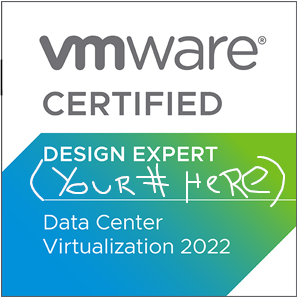Edit: Check out Part 2 of the series here!
Team!
What…is…up, everyone? Things have been a little crazy over here on our side, which is why I have been sticking and posting to social media outlets over writing blog posts. This post is the first of a few in a series that I hope gives a different perspective on VMware’s VCDX certification. I actually wanted to start this months ago, but like I said….lots going on! Anyways, in the name of transparency this post is coming in after about 11 months into my quest for the VCDX. I will mention that I am going for the DCV track so while most details in this post will originate from that mindset the tracks are pretty much all the same in terms of requirements, etc. In this post, I will run down what the VCDX is and give pointers to candidates from a candidate in hopes that it will make your journey a little easier.
What is it?

For those that do not know, the VCDX is the top level of certification that you can get in any track issued by VMware; the crème de la crème, the top dawg, the coveted less-than-300-in-the-world (at the time of writing) marking. The only thing better than having a VCDX is having two VCDXs from different tracks (and the only thing better than that is having three, etc.). It is not like a typical certification though. You do not go online, buy a voucher, schedule an appointment with a testing facility, and take a test…oh, no. No, no, no. Like I said, this is the VCDX, my people! I compare this to writing a dissertation for a doctorate degree, and yes, also defending your paper in front of a panel. You also must do a little role playing where the panelists swap into a “customer” role and provide you with high-level details of a project that their “company” is in need of completing. Your job – architect the solution. Now on to the info!
#1 – Getting Started – Pre-requisites and conversations
Not to scare anyone away from this, but this is a pretty big investment in yourself in terms of time. I have heard of stories of people completing it in as little as six months to people taking as long as three years to submit their documentation. It all depends on your project, your personal situation, and how much time you are willing to invest into it. With that said, if you have a family of your own or a significant other I highly suggest having a conversation when them and letting them know you wish to pursue this certification. This was recommended to me by my mentor, and I took the approach and discussed it with my wife to give her an idea of what I was trying to do and what it entailed. Eleven months in, she has been and still is more than supportive of this journey.
When I first decided to make a run for the VCDX. It literally took me about 2-3 weeks to even figure out where to start, what to do, who I should talk to, etc. With that said, the program is maturing itself and trying to make it easer for candidates to get off on the right foot. Stop #1 should be to VMware’s Certifications page to make sure you meet pre-requisites of holding both the VCP and VCIX, which is an additional two certifications after the VCP, in your respective track.
Note: You do not have to have these to START your VCDX, but you will need them in order to OBTAIN your VCDX. Granted, the VCAPs will help bend your mental a little to get into the “VCDX mentality”.
#2 – The Blueprint
On the same certification page you will find the VCDX blueprint. In my opinion, it is absolutely, positively, without a doubt extremely important to read this document, then read it again. These are the guidelines that MUST be met in your project. You will probably refer back to and re-read this document a few times throughout the process, and that is okay. This will help you not only to select a project that can meet the requirements, but also to remain focused on the specific areas of your project when you are underway. Check out the ‘References’ section below for a link to your track’s landing page where you can find its blueprint.
#3, #4, #5 – The Project
After you read the blueprint you need to figure out a project (or “project”, I will explain shortly why the quotes) that you want to use. I put the word ‘project’ both inside and out of quotes before because this does not have to be a real project that was designed and delivered to a real customer. In fact, it can be completely made up if you want it to be. They project types are typically categorized and real, hybrid, or fully fictitious. Each category has its own pros and cons. In your head, fully-fictitious sounds great because you can make things up as you go, but in reality it is the most difficult of the three because I go into perfectionist mode and try to cover every little detail. Plus, trying to make up and remember all of the finite details that you made up becomes difficult. In the end, I went with a hybrid approach where I took some reality of a few different projects that I have delivered and mixed it with a little bit of fairytale-ism.
When you choose a project, there are a few things that I feel you should keep in mind:
- Yes, it is a VMware certification. That does NOT mean that you need to have a vSphere cluster using vSAN for storage that hosts Horizons VDI secured by micro-segmentation from NSX-T, SRM providing disaster recovery functionality, vROPS for monitoring all done via automation through vRA (unless your requirements back this up).
- You do NOT need to have a project that is a global, $150 billion revenue company with 300,000,000 employees that wants a meshed footprint for every data center that they have which averages to one per country all running production Tier-1 workloads with ten 9s of uptime.
- Your paper does not have to be 1,000 pages depicting every tiny little keystroke that was done to get from Point A to Point Z in your project.
What am I trying to say? You do not get any bonus points for filling your project up with VMware products. You do not get any bonus point for some severely, overly complex project no matter how cool/nerdy they are. You do not get any extra bonus points for page count. At the end of the day when you submit these documents people have to read them. Make their lives easier by making your document clear and concise, leaving out all of the fluff. If you want to go with a complex project, go ahead. Keep in mind you have to defend it at the end of the day. That means you will be accountable for every facet of the design. While this gives you ample room for questions to gain a lot of points, it also gives you the same room the not gain a lot of points if you cannot justify or defend it. On the other side of the coin, your design should not be comprised of just a single 2-node ROBO cluster. Refer back to the blueprint and make sure that you can meet the minimum requirements with your prospective design before you start.
Conclusion
I am going to pause the series here. I know, I know. Just when it was starting to get good. Check us out next week for Part 2 of this series, where we throw some more candidate knowledge at you in hopes of easing your journey. In the ‘References’ section below you will find the aggregated list of important links thus far. At the time of writing, these links were all active. If you witness a broken link in the future, please contact me and I will gladly edit the post to update it.
Thanks for reading. If you enjoyed the post make sure you check us out at dirmann.tech and follow us on LinkedIn, Twitter, Instagram, and Facebook!
References:

Paul Dirmann (vExpert PRO*, vExpert***, VCIX-DCV, VCAP-DCV Design, VCAP-DCV Deploy, VCP-DCV, VCA-DBT, C|EH, MCSA, MCTS, MCP, CIOS, Network+, A+) is the owner and current Lead Consultant at Dirmann Technology Consultants. A technology evangelist, Dirmann has held both leadership positions, as well as technical ones architecting and engineering solutions for multiple multi-million dollar enterprises. While knowledgeable in the majority of the facets involved in the information technology realm, Dirmann honed his expertise in VMware’s line of solutions with a primary focus in hyper-converged infrastructure (HCI) and software-defined data centers (SDDC), server infrastructure, and automation. Read more about Paul Dirmann here, or visit his LinkedIn profile.
